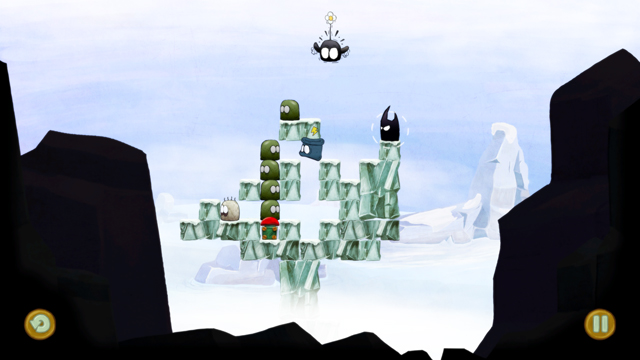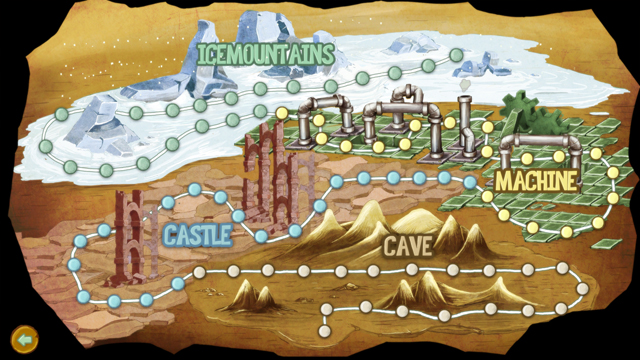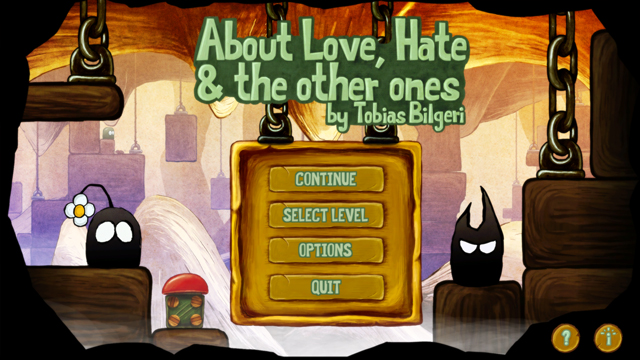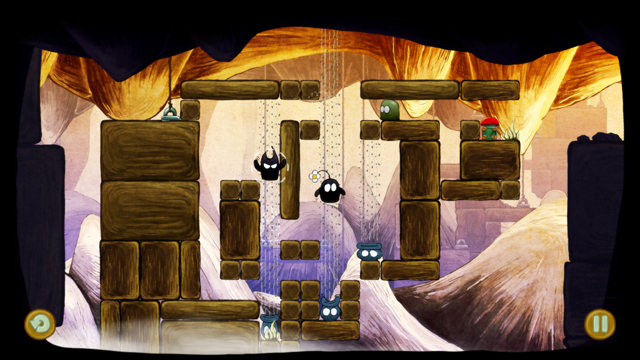I second those emotions.
One of the best pieces of advice I can give you regarding puzzle games, platformer or otherwise, is to step away when a puzzle takes too long to solve. This advice, Dear Reader, could’ve greatly helped me last night. Instead, I let frustration’s grip take ahold of my pride as I laboriously stared at a screen full of sprites who just wouldn’t do what I wanted them to do. So I slept, went to work, set an unusual intention in my yoga practice, came home, loaded the game, and finished the final level in about 10 minutes. So it goes with this and many other puzzle games, I suppose.
Love and Hate are two shadowy blobs who find themselves in a pickle. After pushing on a mysterious red button, they are warped to a peculiar cave full of oddly arranged platforms populated with Other Ones. Love, denoted by a signature daisy on its head, can only tell these blobs, “I love you.” Hate, marked by devilish ears and scowling eyes, unsurprisingly utters, “I hate you.” The Other Ones respond in kind by either coming closer or moving away from them respectively. And this is how Love and Hate must continually find ways to the red button in each stage.
As you progress, the level arrangements become more sinister, and the variety among the Other Ones increases. Aside from the green blobs, some act as mobile air vents for more vertical navigation, robots swap places with the hero who emoted at them, and the dead ones are just that. Sometimes you’ll love and hate all of them, and others will be ignored, only serving as distractions. It helps that they’re all cute (even the dead ones)!
Black Pants Studio, who previously made Tiny and Big: Grandpa's Leftovers, illustrate all sprites in a colored pencil style that is instantly endearing. Unfortunately, backgrounds and blobs don’t change much as you progress through the four worlds and 80 levels, and animations are very sparse with little flair. In fact, there are only three adorable cut-scenes to speak of: one in the beginning, another rather early on, and the final act. Love and Hate’s clearly conflictual relationship with one another is a highlight of these animations, and it’s a disservice to the game’s charm not to reward the player with more of their dopey antics.
Eye boredom aside, the difficulty of the game took a long time to ramp up. It wasn’t until the final ten to fifteen levels that I really had trouble solving puzzles quickly. I certainly restarted a few when I made errors, but the majority were rather straightforward. The difficulty spike in the end felt rather unfortunate as I felt suddenly unprepared for the methods required to tackle the challenges set forth before me.
I should stress that there is nothing wrong with the puzzles themselves; in fact they can be quite smart. Occasionally, they work like a sliding puzzle, finding ways to rearrange the pieces, Other Ones in this context, so that your path to the end is clear. Eventually, levels force Love and Hate to loop around the entire screen to get to seemingly proximal endpoints. I just felt an overly quick shift from straightforward solutions to a significant stress on planning ahead, and I wish the earlier levels set that up more often. To be fair, a friend playing concurrently on mobile felt challenged much sooner than I did, so my experience may not be canon.
Disregarding my opening scenario, About Love, Hate, and the other ones could take you three to four hours. I have over seven logged because of my foolish screen-staring. So if you can get over a lack of graphical variety and animation and a modicum of brainteasing, you’ll fare well in this cute puzzle adventure. I have a small bead of hope that this is not the last I see of Love and Hate.
-
Cute colored pencil sprites and environments
-
Lack of variety over course of game
-
Only 3 cut-scenes
-
Good length at 80 levels
-
Increasingly crafty puzzles
-
Strong difficulty spike near end
About Love, Hate, and the other ones
-
About Love, Hate, and the other ones #1

-
About Love, Hate, and the other ones #2

-
About Love, Hate, and the other ones #3

-
About Love, Hate, and the other ones #4

-
About Love, Hate, and the other ones #5

-
About Love, Hate, and the other ones #6








